 W
WLoriini is a tribe of small to medium-sized arboreal parrots characterized by their specialized brush-tipped tongues for feeding on nectar of various blossoms and soft fruits, preferably berries. The species form a monophyletic group within the parrot family Psittacidae. The group consist of the lories and lorikeets. Traditionally, they were considered a separate subfamily (Loriinae) from the other subfamily (Psittacinae) based on the specialized characteristics, but recent molecular and morphological studies show that the group is positioned in the middle of various other groups. They are widely distributed throughout the Australasian region, including south-eastern Asia, Polynesia, Papua New Guinea, Timor Leste and Australia, and the majority have very brightly coloured plumage.
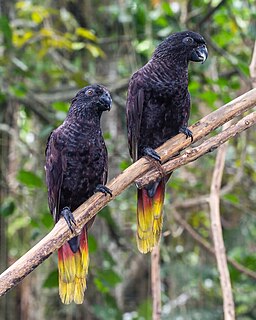 W
WThe black lory also known as rajah lory or red-quilled lory is a medium-sized, blackish parrot with black bill, dark grey feet and long rounded tail. It has yellow and red under-tail. The sexes are similar. It is native to West Papua in Indonesia.
 W
WChalcopsitta is a genus of parrot in the family Psittaculidae and the subfamily Loriinae. All three species are native to New Guinea and western offshore islands. The name Chalcopsitta is derived from the Greek khalkos meaning "bronze" and psitta meaning "parrot".
 W
WCharmosyna is a genus of parrots in the family Psittaculidae.
 W
WCharmosynopsis is a genus of parrots in the family Psittaculidae that are endemic to New Guinea, the southern Maluku Islands.
 W
WThe conquered lorikeet is a species of parrot that became extinct 700–1300 years ago. It lived in islands of Polynesia. David Steadman and Marie Zarriello wrote its species description in 1987.
 W
WThe dusky lory is a species of parrot in the family Psittaculidae. Alternative common names are the white-rumped lory or the dusky-orange lory. It is found in New Guinea and the offshore islands of Batanta, Salawati and Yapen. They are also known as "banded lories" or "duskies".
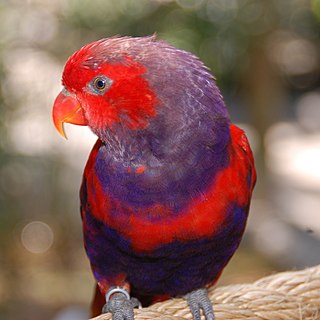 W
WEos is a genus of parrots belonging to the lories and lorikeets tribe of the family Psittaculidae. There are six species which are all endemic to islands of eastern Indonesia, most within very restricted ranges. They have predominantly red plumage with blue, purple or black markings. Males and females are similar in appearance.
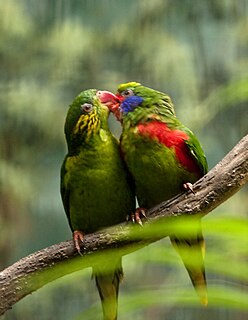 W
WHypocharmosyna is a genus of parrots in the family Psittaculidae that are endemic to New Guinea, the Maluku Islands and the Bismarck Archipelago.
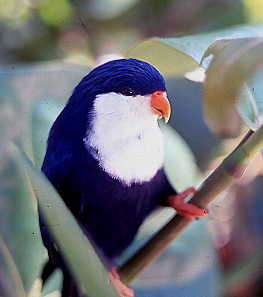 W
WThe blue lorikeet is a small lorikeet from French Polynesia and the Cook Islands. It is also known as the Tahiti lorikeet, violet lorikeet, Tahitian lory, blue lory, nunbird, and the indigo lory. It was formerly found on 23 islands around Tahiti, but now restricted to perhaps eight islands: Motu, Manuae, Tikehau, Rangiroa, Aratua, Kaukura, Apataki, Aitutaki, and possibly Harvey Island and Manihi. Its plumage is mainly dark blue and it has a white area over its upper chest, throat and face. The first captive breeding in the UK was by the Marquess of Tavistock in the 1930s. He was awarded a silver medal by the Foreign Bird League for this achievement.
 W
WThe blue-crowned lorikeet, also known as the blue-crowned lory, blue-crested lory, Solomon lory or Samoan lory, is a parrot found throughout the Lau Islands (Fiji), Tonga, Samoa, Niue and adjacent islands, including: ʻAlofi, Fotuhaʻa, Fulago, Futuna, Haʻafeva, Niuafoʻou, Moce, Niue, Ofu, Olosega, Samoa, Savaiʻi, Tafahi, Taʻu, Tofua, Tonga, Tungua, ʻUiha, ʻUpolu, Varoa, Vavaʻu, and Voleva. It is a 19 cm green lorikeet with a red throat, blue crown, and belly patch shading from red at the top to purple at the bottom.
 W
WGoldie's lorikeet is a species of parrot in the family Psittaculidae. It is the only species placed in the genus Glossoptilus. It is found in forest and woodland in New Guinea, primarily at altitudes of 1000–2200 m. It is mostly green with yellowish streaks in the chest area, and a red, blue and purple head. It is a small bird measuring 19 cm in length and weighing 45–60 grams.
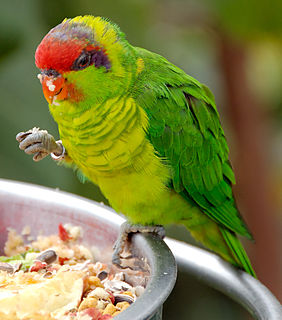 W
WThe iris lorikeet is a small, up to 20 cm long, green lorikeet bird. The male has a red forehead, yellow nape, purple band back from eye between nape and cheek, and yellowish below. The female almost similar with red-marked green forecrown and yellowish green cheek.
 W
WThe little lorikeet is a species of parrot in the family Psittaculidae. It is endemic to Australia. It is a small parrot, predominantly green in plumage with a red face. Its natural habitats are subtropical or tropical dry forest and subtropical or tropical moist lowland forest.
 W
WThe orange-billed lorikeet is a species of parrot in the family Psittaculidae. It is found in New Guinea. Its natural habitat is subtropical or tropical moist montane forests.
 W
WThe plum-faced lorikeet, also known as the whiskered lorikeet, is a species of parrot in the family Psittaculidae. It is monotypic within the genus Oreopsittacus. It is found in the New Guinea Highlands.
 W
WThe Pohnpei lorikeet, known as serehd in Pohnpeian, is a species of parrot in the family Psittaculidae. It is endemic to the island of Pohnpei and the nearby Ahnd Atoll in Micronesia. Historically the species also occurred on Namoluk Atoll near Chuuk, and the species may once have had a wider distribution throughout Micronesia than it does today.
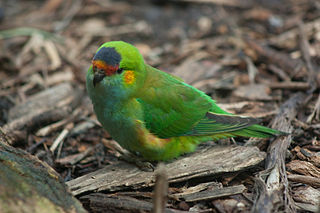 W
WThe purple-crowned lorikeet, is a lorikeet found in scrub and mallee of southern Australia. It is a small lorikeet distinguished by a purple crown, an orange forehead and ear-coverts, and a light blue chin and chest.
 W
WThe rainbow lorikeet is a species of parrot found in Australia. It is common along the eastern seaboard, from northern Queensland to South Australia. Its habitat is rainforest, coastal bush and woodland areas. Six taxa traditionally listed as subspecies of the rainbow lorikeet are now treated as separate species.
 W
WThe red-collared lorikeet is a species of parrot found in wooded habitats in northern Australia. It was previously considered a subspecies of the rainbow lorikeet, but today most major authorities consider them as separate species. No other member of the rainbow lorikeet group has an orange-red collar over the nape.
 W
WThe red-flanked lorikeet is a species of parrot in the family Psittaculidae. It is found in Mollucas, New Guinea and the Bismarck Archipelago. Its natural habitats are subtropical or tropical moist lowland forests and subtropical or tropical mangrove forests. Only the adult males have the red plumage on the head and sides.
 W
WStephen's lorikeet, also known as the Henderson lorikeet or the Henderson Island Lorikeet, is a species of parrot in the family Psittaculidae. It is endemic to Henderson Island in the Pitcairn Islands of the South Pacific.
 W
WThe varied lorikeet, is a species of parrot in the family Psittacidae that is endemic to the northern coastal regions of Australia. It is the only species in the genus Psitteuteles.
 W
WLorius is a genus of lory in the parrot family Psittaculidae. The genus contains six species that are distributed from the Moluccas in Indonesia through New Guinea to the Solomon Islands. They have characteristic red plumage with varying amounts of blue, green wings, and in all but one species a black crown. The bills are orange and the feet are grey. With lengths of up to 25 to 30 cm and average weights of 132 to 190 g, the members of this genus tend to be the largest of the Loriinae subfamily.
 W
WThe black-capped lory also known as western black-capped lory or the tricolored lory, is a parrot found in New Guinea and adjacent smaller islands. It is a colourful and relatively robust lory (31 cm). There are seven subspecies, all with green wings, red heads and body around the wing, a black cap, grey-black cere, yellow underwings, and blue legs and belly. Most also have a blue nape and mantle. It remains overall widespread and common, but the subspecies cyanuchen is relatively rare, with fewer than 5000 individuals remaining.
 W
WThe blue-eared lory is a parrot found only on the island of Seram in Maluku province, Indonesia.
 W
WThe blue-streaked lory is also known as the blue-necked lory. It is a medium-sized parrot (31 cm), which is found on the Tanimbar Islands and Babar in the southern Moluccas.
 W
WThe brown lory, also called Duyvenbode's lory, is a species of parrot in the family Psittaculidae native to New Guinea.
 W
WThe cardinal lory is a species of parrot in the family Psittaculidae. The cardinal lory lives mainly in the mangrove and the lowland forests of the Solomon Islands, Bougainville Island and easternmost islands of the Bismarck Archipelago. It was previously found in the genus Chalcopsitta.
 W
WThe purple-bellied lory is a species of parrot in the family Psittaculidae. It is endemic to Papua New Guinea. It is found in south-east New Guinea, the Bismarck Archipelago, the d'Entrecasteaux Islands, the Louisiade Archipelago, the Trobriand Islands and Woodlark Island.
 W
WThe purple-naped lory is a species of parrot in the family Psittaculidae. It is forest-dwelling endemic to the islands of Seram, Ambon, and perhaps also Haruku and Saparua, South Maluku, Indonesia. It is considered endangered, the main threat being from trapping for the cage-bird trade.
 W
WThe red lory is a species of parrot in the family Psittaculidae. It is the second-most commonly kept lory in captivity, after the rainbow lorikeet.
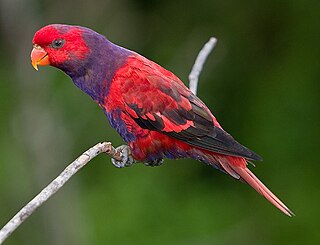 W
WThe violet-necked lory is a species of parrot in the family Psittaculidae. It is endemic to Indonesia, where it is found in the northern Maluku Islands and west Papuan islands. Its natural habitats are tropical moist lowland forests and tropical mangrove forests.
 W
WThe yellowish-streaked lory, also known as the streaked lory or yellow-streaked lory, is a species of parrot in the family Psittaculidae.
 W
WNeopsittacus is a genus of parrot in the family Psittaculidae. The genus contains two species, both of which are native to New Guinea.
 W
WThe New Caledonian lorikeet is a potentially extinct lorikeet endemic to the Melanesian island of New Caledonia.
 W
WParvipsitta is a parrot genus of in the family Psittaculidae. They are native to Australia. The group was previously placed in the genus Glossopsitta.
 W
WPseudeos is a genus of parrot in the family Psittaculidae.
 W
WThe red-and-blue lory is a small, strikingly-colored parrot endemic to Indonesia. The species inhabits a single island, Karakelang, in the Indonesian archipelago.
 W
WSaudareos is a genus of parrot in the family Psittaculidae.
 W
WTrichoglossus is a genus of lorikeet in the Psittaculidae or true parrot superfamily. The genus is distributed widely through Australia, Wallacea and Melanesia, with outliers in the Philippines and Micronesia. Members of the genus are characterised by barring, sometimes prominently, on the upper breast.
 W
WVini is a genus of birds in the family Psittaculidae that are endemic to the islands of the tropical Pacific. There are eleven extant species of these small lorikeets ranging from eastern Fiji through Samoa, French Polynesia, and as far east as Henderson Island. All members of the genus have exceptional bright plumage, particularly the unusual all over blues of the blue lorikeet and the ultramarine lorikeet.